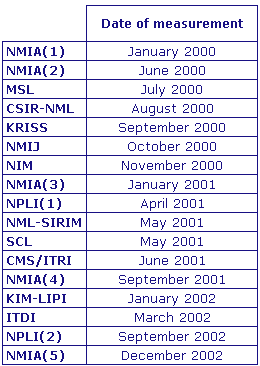

MEASURAND : Central length of long gauge blocks measured by interferometry according to ISO 3650 or by comparison; gauge block material : steel
NOMINAL VALUES : 3 gauge blocks with lengths 200 mm, 250 mm and 500 mm
Degrees of equivalence, Di and expanded uncertainty Ui, of each laboratory i with respect to the reference value for each gauge block k (k = 1 to 3), expressed in nm
L1 = 200 mm, S/N 18743
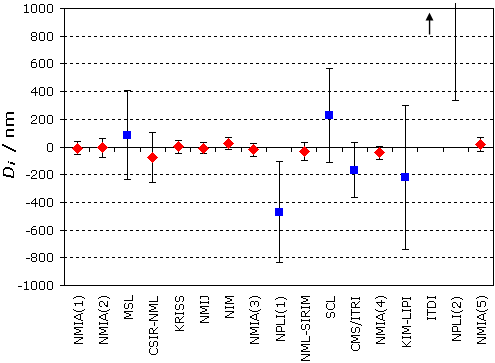
Red diamonds: measurements by interferometry
Blue squares: measurements by comparison
DIDTI = 13286 nm and UIDTI = 4800 nm (comparison)
DNPLI(2) = 1162 nm and UNPLI(2) = 862 nm (comparison)
L2 = 250 mm, S/N 980272
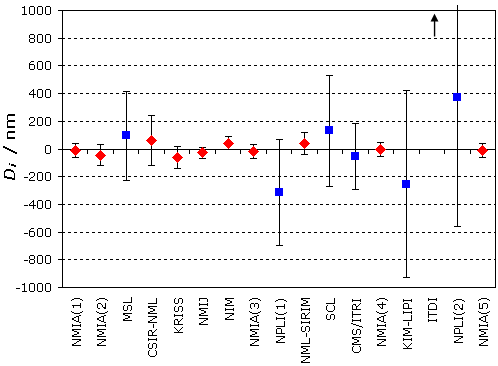
Red diamonds: measurements by interferometry
Blue squares: measurements by comparison
DIDTI = 31642 nm and UIDTI = 3400 nm (comparison)
L3 = 500 mm, S/N 980387
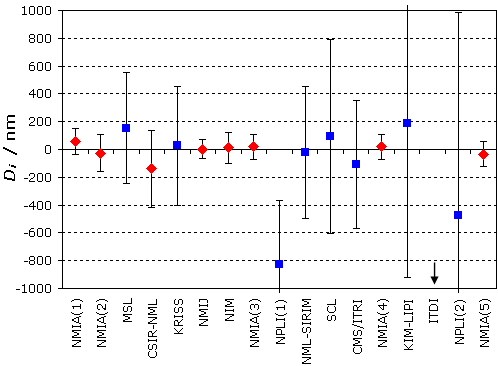
Red diamonds: measurements by interferometry
Blue squares: measurements by comparison
DIDTI = -18129 nm and UIDTI = 3000 nm (comparison)
MEASURAND : Central length of long gauge blocks measured by interferometry according to ISO 3650 or by comparison; gauge block material : steel
NOMINAL VALUES : 3 gauge blocks with lengths 200 mm, 250 mm and 500 mm
Degrees of equivalence, Di and expanded uncertainty Ui, for each nominal length.
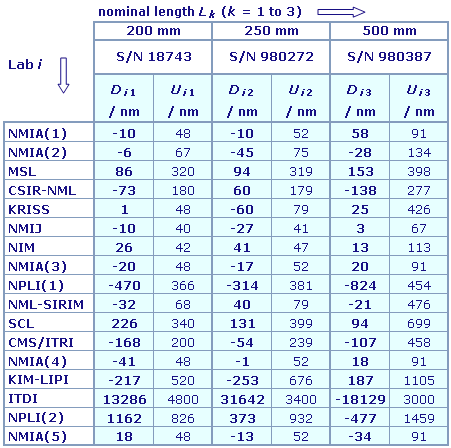
Results are presented under A4 printable format in Summary Results (.PDF file).
| Metrology area, Sub-field | Length, Dimensional Metrology |
| Description | Long gauge blocks from 200 to 500 mm |
| Time of measurements | 2000 - 2002 |
| Status | Approved for equivalence |
| Final Reports of the comparisons | |
| Measurand | Length: 200 mm, 250 mm and 500 mm |
| Transfer device | Three long gauge blocks |
| Comparison type | Key Comparison |
| Consultative Committee | CCL (Consultative Committee for Length ) |
| Conducted by | APMP (Asia Pacific Metrology Programme) |
| Comments | Results published on 22 May 2006 Long gauge blocks by interferometry or by comparison |
| Pilot institute |
NMIA
National Measurement Institute, Australia Australia |
| Contact person | N. Brown +61 2 9413 7157 |
| Pilot laboratory | |
|---|---|
| NMIA |
National Measurement Institute, Australia, Australia, APMP |
| CMS/ITRI |
Industrial Technology Research Institute/Center for Measurement Standards, Chinese Taipei, APMP |
| CSIR-NML |
Council for Scientific and Industrial Research, National Metrology Laboratory (became NMISA in 2007), South Africa, AFRIMETS |
| KRISS |
Korea Research Institute of Standards and Science, Korea, Republic of, APMP |
| MSL |
Measurement Standards Laboratory, New Zealand, APMP |
| NIM |
National Institute of Metrology, China, APMP |
| NMIJ AIST |
National Metrology Institute of Japan, Japan, APMP |
| NML-SIRIM |
National Metrology Laboratory, SIRIM Berhad (became NMIM), Malaysia, APMP |
| NPLI |
CSIR National Physical Laboratory of India, India, APMP |
| NSCL |
National Standards and Calibration Laboratory, Syrian Arab Republic, APMP |
| Puslit KIM-LIPI (became SNSU-BSN) |
Research Center for Calibration, Instrumentation and Metrology – Indonesian Institute of Sciences (became National Measurement Standard - National Standardization Agency of Indonesia), Indonesia, APMP |
| SCL |
Standards and Calibration Laboratory, Hong Kong, China, APMP |
| SPRING Singapore |
Singapore Standards, Productivity and Innovation Board (became NMC, A*STAR in 2008), Singapore, APMP |
| STD-ITDI (now NMLPHIL) |
Standards and Testing Division, Industrial Technology Development Institute (now National Metrology Laboratory of the Philippines), Philippines, APMP |
This page proposes print-out on A4 paper (portrait) of the comparison details (best printed out using a black and white printer).
Please, select items to be printed out, then click on "OK" :
MEASURAND : Central length of long gauge blocks measured by interferometry according to ISO 3650 or by comparison; gauge block material : steel
NOMINAL VALUES : 3 gauge blocks with lengths 200 mm, 250 mm and 500 mm
|
The APMP key comparison reference value, xRk, for each gauge block k, is determined from the linear function xFk(t), where t is the date of measurement, obtained by fitting a straight line to participants' values xik (with weights based on each reported uncertainty uik) and by adding a value Ck(t) chosen such that the reference value is the nominal length: xRk = Lk = xFk(t) + Ck(t). The linear regression determines two constants Ak and Bk and assumes a linear change in length with time: |
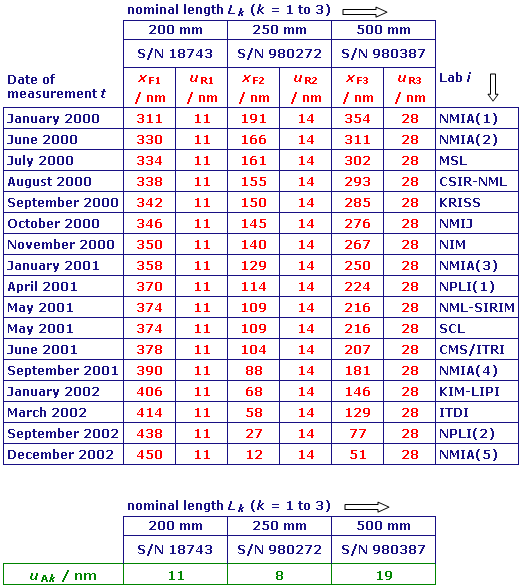
|
The degree of equivalence of each laboratory i with respect to the reference value for each gauge block k is given by a pair of terms: the difference Dik and its expanded uncertainty Uik (coverage factor: 2) with |
|
The calculation of the degree of equivalence between two laboratories i and j is not recommended for comparisons involving several material standards, since it cannot be expressed with a single pair of terms. It would have to be calculated separately for each gauge block k and would then be given by a pair of terms: |
Key comparison APMP.L-K2 is parallel to key comparison CCL-K2. Numerical linking of these comparisons is not recommended due to artefact dependent offsets. Instead, laboratories participating competently in both key comparisons establish the link and assure equivalence.
MEASURAND : Central length of long gauge blocks measured by interferometry according to ISO 3650 or by comparison; gauge block material : steel
NOMINAL VALUES : 3 gauge blocks with lengths 200 mm, 250 mm and 500 mm
xik : result of measurement carried out by laboratory i for gauge block k with nominal length Lk, expressed as the deviation from nominal length in nm
uik : combined standard uncertainty of xik reported by laboratory i
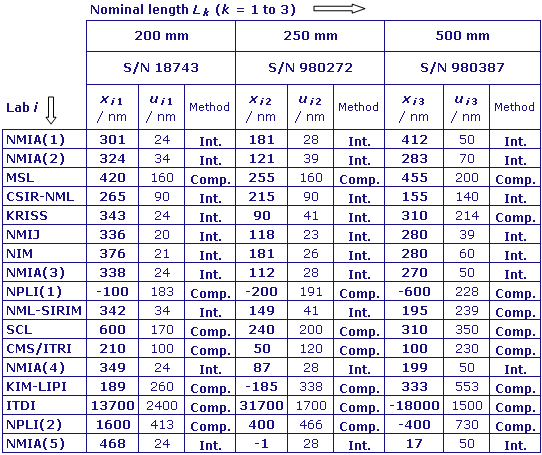
Methods: "Int." for interferometry, "Comp." for comparison.
SPRING Singapore was unable to participate due to instrument failure.
NPLI asked for a re-measure.
The artefacts were measured five times at the Pilot Laboratory (NMIA) with the same method, in order to provide information on artefact changes with time.
